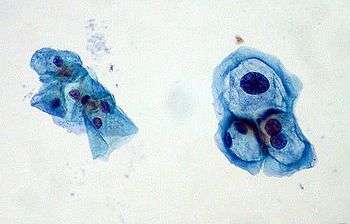Koilocyte
A Koilocyte is a squamous epithelial cell that has undergone a number of structural changes, which occur as a result of infection of the cell by human papillomavirus.
Koilocytosis or koilocytic atypia or koilocytotic atypia are terms used in histology and cytology to describe the presence of koilocytes in a specimen.[1]
Koilocytes may have the following cellular changes:
- Nuclear enlargement (two to three times normal size)
- Irregularity of the nuclear membrane contour
- A darker than normal staining pattern in the nucleus, known as Hyperchromasia
- A clear area around the nucleus, known as a perinuclear halo.
Collectively, these types of changes are called a cytopathic effect; various types of cytopathic effect can be seen in many different cell types infected by many different types of virus.[2][3]
When examining cytologic specimens, mild koilocytosis is characteristic of ASC-US (atypical squamous cells - undetermined significance). A more undifferentiated koilocyte, possessing a more hyperchromatic and enlarged nucleus, and a higher degree of cytoplasmic clearing with a discernible peripheral rim favor an interpretation of LSIL (low-grade squamous intraepithelial lesion).[1][2]
Koilocytes may be found in potentially precancerous cervical, oral and anal lesions.[3]
Interpretation
These changes occur in the presence of human papillomavirus and occasionally can lead to cervical intraepithelial neoplasia, and if left untreated some may eventually progress to malignant cancer.
References
- 1 2 Nucci MR, Oliva E, eds. (2009). Gynecologic pathology: A volume in the series - Foundations in diagnostic Pathology. Elsevier Churchill Livingstone. ISBN 978-0-443-06920-8.
- 1 2 DeMay, Richard M. (2007). Practical Principles of Cytopathology Revised. American Society for Clinical Pathology. ISBN 0-89189-549-3.
- 1 2 Krawczyk E, Suprynowicz FA, Liu X, et al. (September 2008). "Koilocytosis: a cooperative interaction between the human papillomavirus E5 and E6 oncoproteins". Am. J. Pathol. 173 (3): 682–8. doi:10.2353/ajpath.2008.080280. PMC 2527066
 . PMID 18688031.
. PMID 18688031.
